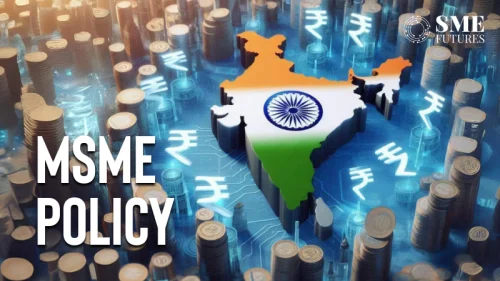India’s ambitious climate goals and its pledge to achieve net-zero emissions by 2070, necessitate innovative solutions. The Carbon Credit Trading Scheme (CCTS) can be a pivotal instrument to drive this transition. By establishing a market-based mechanism to incentivise emissions reduction, the CCTS aims to foster green growth, attract investments, and contribute to global climate action.
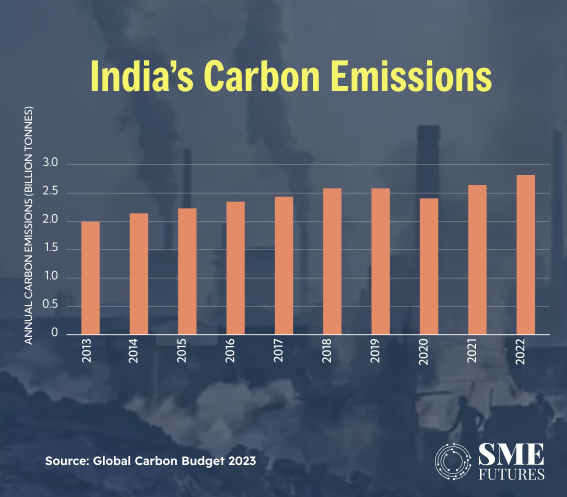
Understanding the CCTS
The CCTS is a market-based mechanism to check emissions. It operates on a cap-and-trade system. Industries are allocated a certain amount of carbon emissions, represented by carbon credits. If they exceed their limit, they must purchase additional credits from those who have surplus. Conversely, if they reduce emissions below their cap, they can sell their excess credits. This market-based approach encourages industries to adopt cleaner technologies and practices, ultimately reducing their carbon footprint.
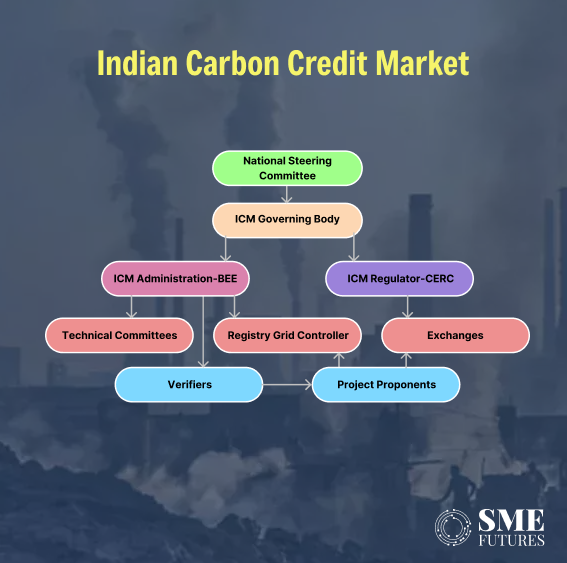
Assistant Professor Srijith Mohanan, JAGSoM, Bengaluru, says, “The new CCTS framework is a step in the right direction. It underscores our commitment to sustainable growth – creating a market-based mechanism to incentivise technology investments to reduce emissions. While the policy is comprehensive and progressive, implementation would be the key to achieving our NDC goals for 2030.”
“One – it requires an exchange to facilitate trading of CCCs. Two – it requires close scrutiny for issuance of CCCs, like annual setting of emission limits, measurement of actual emissions, evaluation of output levels, etc. As a nation, we have considerable expertise on the former, with world class systems for security exchange. However, our experience in monitoring and enforcement of quality standards in other industries has been a bit mixed.
Therefore, setting up an efficient, transparent and credible CCC issuance system would be central to defining the success level of the new CCTS framework,” he adds.
Role of technology and international collaboration
Technology plays a crucial role in the success of the CCTS. Blockchain technology can enhance transparency and security in carbon credit trading. Artificial intelligence and Machine Learning can be employed to optimise emissions reduction strategies and identify new opportunities.
International collaboration is also essential for the growth of India’s carbon market. By aligning with global standards and participating in international carbon markets, India can attract foreign investment, promote technology transfer, and contribute to global climate action.
The success of India’s carbon market also depends on the availability of skilled professionals. As Vijayaraj Palaniraj, Head of Talent Acquisition at EQ India, emphasises, “Financial Services is a high trust industry and hence, the key competency is the ability to understand risk, adhere to processes and the ability to call out anything that doesn’t fit the picture.”
By developing a skilled workforce, India can ensure the effective implementation and management of the CCTS.
Challenges and opportunities
While the CCTS holds immense potential, several challenges need to be addressed to ensure its success.
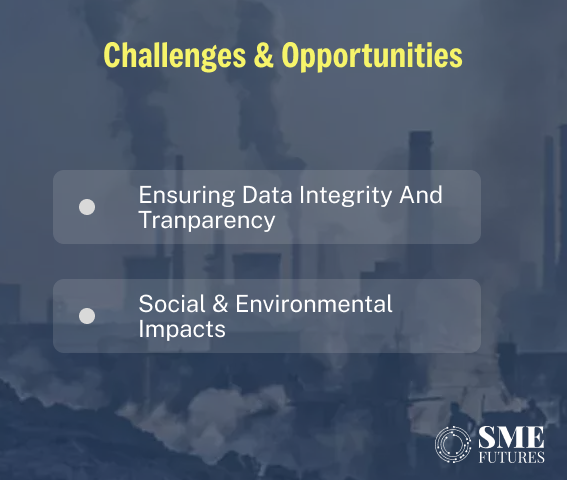
Ensuring data integrity and transparency:
Accurate emissions measurement is the first step towards ensuring transparency. Developing robust methodologies to accurately measure and report emissions is crucial. This involves addressing challenges like data quality, consistency, and comparability across sectors. To verify carbon credits, establishing rigorous verification and certification processes is essential to maintain its credibility. This includes third-party audits, independent verification, and robust documentation.
Ensuring that carbon credits are not claimed multiple times across different jurisdictions is vital. International cooperation and coordination are necessary to avoid double counting and maintain the integrity of the global carbon market.
Smitha Shetty, Regional Director, APAC – Achilles Information Ltd says that mapping all tiers of suppliers to identify emission hotspots and collaborating with them to collect accurate emissions data is important. Tools like the Achilles Carbon Management Module can streamline this data collection process, helping establish a baseline for tracking progress and identifying reduction opportunities.
“Engaging and collaborating with suppliers is equally important. Companies must clearly communicate their sustainability goals and requirements, providing support and guidance to help suppliers improve their environmental performance. Incentivising improvement through sustainable procurement practices can further encourage suppliers to prioritize emissions reduction,” Shetty adds.
Addressing social and environmental impacts:
The transition to a low-carbon economy should be equitable and inclusive. It’s important to consider the social and economic impacts on workers, communities, and vulnerable populations. There should be great emphasis on sustainable land usage. Carbon sequestration projects, such as afforestation and reforestation, should be carefully planned and implemented to avoid unintended consequences like deforestation and land degradation. Respecting the rights of indigenous communities and ensuring their involvement in decision-making processes is crucial.
Protecting community rights
Satyam Vyas, Founder and CEO of Climate Asia, says India’s carbon markets can be powerful tools for social equity and environmental justice when inclusively designed. He cites the example of Kenya’s Kasigau Corridor REDD+ Project which demonstrates how carbon credits support local development by creating jobs in agroforestry and forest protection and reducing emissions. “Similar models in India could focus on renewable energy, sustainable agriculture, and forest preservation, benefiting rural and tribal areas. The Global Commission on Adaptation (2019) supports this approach, emphasising community-led adaptation as central to resilience,” he elaborates. This will not only bring about sustainability but also protect the community’s interests.
Successful models like the Fairtrade Carbon Credits Initiative return revenue to local farmers and cooperatives, benefiting smallholders through emissions reduction projects. India could similarly establish community-owned projects where carbon revenues support sustainable agriculture and energy initiatives.
IIED’s Report on Equitable Carbon Markets (2021) also underscores the importance of community-centred benefit-sharing agreements. South Africa’s carbon market offers another example by using transparent monitoring and grievance redressal systems to protect community rights and interests.
Role of civil society and the private sector
Civil society organisations can play a crucial role in monitoring and advocating for the integrity of the carbon market. They can also help raise awareness about climate change and promote sustainable practices.
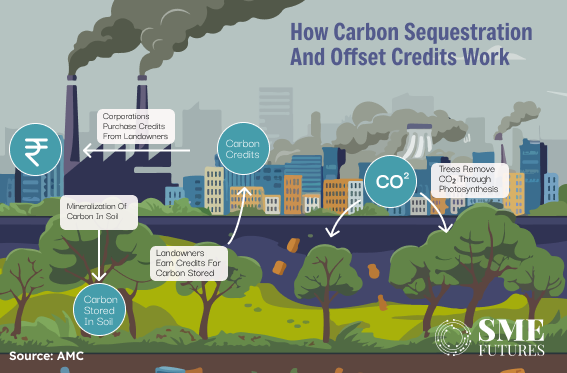
The private sector, including corporations and financial institutions, has a significant role to play in driving the transition to a low-carbon economy. By investing in clean technologies, adopting sustainable business practices, and supporting carbon offset projects, businesses can contribute to a greener future.
Satyam Vyas says that Civil Society Organizations (CSOs) are essential for building a credible and equitable carbon market. Globally, organisations like the Environmental Defence Fund demonstrate how independent monitoring can reinforce transparency.
In India, organisations like the Centre for Science and Environment (CSE) play a similar role, providing on-the-ground data, educating communities, and bridging policy-practice gaps. The World Resources Institute (2021) highlights CSOs’ role in enhancing accountability and building community capacity, enabling local groups to manage and benefit directly from carbon projects.
A deeper dive into the potential of India’s carbon market
The need for tech:
Smitha Shetty says that emerging trends in sustainable supply chain practices in India highlight a substantial shift towards transparency, carbon neutrality, circular economy principles, and deeper collaboration across supply chain tiers. “Companies increasingly leverage advanced technologies like AI-driven analytics and blockchain to enhance visibility and traceability, ensuring alignment with evolving environmental and regulatory standards,” she asserts.
Satyam Vyas says that despite some challenges, technology offers transformative opportunities for India’s carbon market. Blockchain, IoT, and AI can boost transparency, as demonstrated by Regen Network, which uses blockchain to verify sustainable land management. This model could help India track emissions reductions and enable real-time data reporting.
The Ministry of Electronics and Information Technology’s Digital Divide Study (2021) highlights rural barriers to tech access, which partnerships can help address. India’s Global Innovation Lab for Climate Finance (2022) pilot used remote sensing to monitor agricultural emissions, bridging the gap for rural stakeholders. Such examples show how technology can streamline processes while requiring tailored solutions for accessibility.
Fostering innovation and entrepreneurship:
Supporting start-ups and small and medium-sized enterprises focused on climate solutions can drive innovation and create new business opportunities. Developing green financial instruments, such as green bonds and climate-focused venture capital funds, can mobilise capital for low-carbon projects.
Smitha Shetty explains that key regulatory developments, particularly SEBI’s BRSR Core framework, have been instrumental in embedding sustainability within corporate strategies. By mandating detailed ESG disclosures for India’s listed companies, the BRSR Core has elevated sustainability as a strategic priority, fostering greater transparency and accountability.
“Beyond large corporations, the framework’s impact extends downstream to MSMEs, as it drives larger companies to hold their suppliers to higher sustainability standards. This ripple effect encourages MSMEs to adopt sustainable practices, enabling capacity building, improved access to financing, and enhanced market competitiveness,” she says.
Building a skilled workforce:
Investing in education and training programmes to develop a skilled workforce is crucial for the success of the CCTS. Supporting capacity building initiatives for government officials, industry professionals, and civil society organisations can enhance their understanding of the carbon market and its implications.
What’s next for India
India’s carbon market is a powerful tool to drive sustainable development and contribute to global climate action. By addressing the challenges, leveraging technology, and fostering international collaboration, India can unlock the full potential of this market-based mechanism. As Satyam Vyas says, “India can achieve intertwined environmental and social goals by enabling local stakeholders to lead and gain from carbon projects. India’s carbon market has significant potential to align with global initiatives like the Paris Agreement by establishing clear standards and protocols. For instance, alignment with Article 6 mechanisms could increase international trading and financing opportunities.”
Smitha Shetty says that to adapt, companies must foster collaborative relationships with suppliers, invest in sustainable technologies, and adopt robust ESG reporting frameworks to measure and disclose their environmental impact accurately.
By embracing a holistic approach that considers the social, environmental, and economic dimensions of climate change, India can position itself as a global leader in the fight against climate change.








